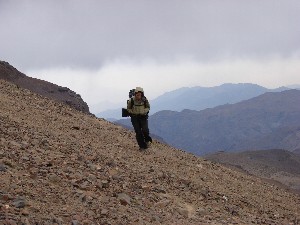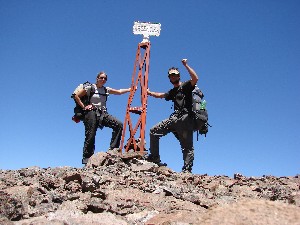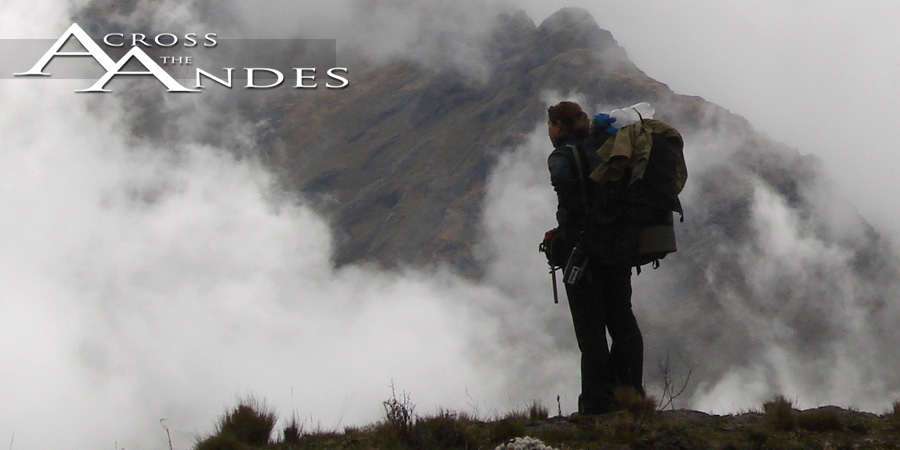Grapes and Ore
By Deia Schlosberg
February 20, 2007

We have certainly picked up the pace this last section. Every day has become more about hiking and covering distance, which I suppose is a good thing since we have several thousand miles left to walk. As of our last update, we were still without a GPS. Now, we are most definitely with one. I'm not sure what we were thinking before. That's not true: we were enchanted with the idea of navigating through all of the Andes with a map (or 104 of them) and compass. How romantic. But alas, score another one for technology; the device has certainly sped things along and saved us many hours of aggravation. It is not fun to take a route that looks perfectly tame on the map only to find it impassible and necessitating a dreaded turn-around after the good part of a day struggling up it. This previously frequent occurrence has not happened since the acquisition of the unit. Also a brilliant feature of our high-tech new machine: an alarm. Although this is against the will and moral sense of both Gregg and I, it has gained us a good hour and a half more of daylight, and thus hiking, each day. However, even with these changes, we have found time to hang out in a fig tree with a few nine-year-olds, slow-roast some brats over a campfire, interview gauchos, and fend off an excessively territorial turkey (they can be much larger and more aggressive than one would ever think). Another big lesson from this last month: when on a thru-hike, never underestimate the importance of shoes in a single piece.
We began, actually, in Santiago, having returned for better maps, and though we didn't know it yet, a GPS. I was robbed there, unfortunately. I don't want to deter anyone from international travel or further the fear of South America as dangerous by saying so, however. In fact, the reason I was robbed is because Santiago is such a nice city that I let my guard down a little too much, I suppose. I lost my camera (friggin' tragic), our passports, money, cards, contacts of many new Peruvian friends, a Melanzana shirt, my headlamp, and so on. We hoped the stinker who did it liked to backpack for all the little accouterments he got. I could have been more careful for sure, but it really did suck. On the upside, it was nice to have less weight hiking for the past month, and my replacement camera is digital, which means I don't have to wait until I get home and get a job to afford printing the rest of my pictures. Moral: unfortunately, there are a few people in the world that will do mean things, and for them, you must be aware at all times. So after replacing a few essentials, it was back to the beauty and security of the hills.
Our most direct route north would take us far up into the mountains, where we would cross into Argentina over a pass and then cross back into Chile a few days later. Because of the layout of the mountains and the roads and trails in and out, this was the first time in the trip where we knew that if a ridge was impassible in the fourth or firth day, we would run out of food if we had to turn around. We wouldn't run out for long enough to be unsafe, but definitely long enough to need a very, very big meal by the time we reached a resupply point again. Our route looked solid but challenging on both the maps and the GPS. We took off with a cautious confidence and excitement. We soon found ourselves in high, open valleys with peaks of incredible color rising all around us. Only a few goatherds live their high, solitary lives there, in small stone houses. Most of our interactions with them were politely curt. They seemed curious enough to ask what we were doing, but not wowed by it, as many of our other campesino friends to the north have been. They seemed the kind of people that very little would phase. I am impressed by them and how they live. I think it's interesting that solitude makes people quieter rather than having them soak up human interaction when it becomes available.

Our crossing of the border was refreshing. Borders are nicer when they are defined by natural features, like watersheds, but the idea of a line separating people and rules and culture is odd. Where we crossed into Argentina, the idea of a line of separation became almost absurd. Nothing changed, no one was there, no forms were filled out; we simply kept walking across the continuous land. A large, two-sided metal pylon marked the line, reading "Argentina" on the Argentina side and "Chile" on the Chile side. How and why the sign was carried there was not so unlike Chile's other great mystery, Easter Island. Anthropologists in the future will have fun with this one, too.
It turned out that our most questionable passes, though decent climbs, had footpaths/goat-trails over them, and thus, with their switchbacks, weren't nearly as steep to get up as the topo lines had indicated. Some of the excitement was lost, but it made for a smoother, quicker journey with no less beauty. Our crossing back into Chile was similarly uneventful, and we finished the day with a 26+ mile total, much of the last part, unfortunately, on a dirt mining road.
After a resupply and a shoe swap, due to some unruly soles, we met the Álvarez family. The whole lot of them, including aunts and cousins and grandparents, took us in for the night and much of the next day, feeding us a couple of lovely meals and lots of fruit. The kiddos gave us a great tour of the home and surrounding area, with a great tree-climb as the highlight. All this just minutes after saying how much we missed the family interactions we had more of in Ecuador and Peru. The gods apparently heard and Chile answered.
For the last week, we walked through desert, only crossing several streams the whole time. Lots of cacti, lots of plants with thorns, lots of sun, and still, mountains. Just about once a day or two, we would cross a valley that was devoted to vineyards. It was a fine sight, even though somewhat artificial, to get to the top of a ridge after only seeing rock, sand and spikey plants for a long time and view an enormous valley completely filled with lush greenness. Not to mention the snacking that would soon ensue. They didn't mind. We later learned from our friend Hector, who works with one of the big companies, that the grape industry in Chile does what it can to have a small environmental impact. I had been wondering what all the effects were, and though I don't know for sure if the effort is a result of real caring on their part or business image, Hector brought it up, so it's good to know an executive in the industry has long-term impact on his brain.
We spent a fair amount of time on our final ridge top before descending into the last of the valleys for this section. It was a pretty cool feeling to look south and see where we had just lived and walked through over the past week, and to look north and see the mountains that will be home for the next week as we keep going. We do take a fair amount of time calculating and planning our route, but after all that, really, we just go. And it really is pretty special to look out at a view-ful of earth and valley and know that you can and will walk over the whole of it and start to get to know it on a level that most can't conceive of. I fall more in love with our planet and what's on it every day, and that comes from knowing it. Go for a hike if you're able and haven't in a while. It's a good thing to do.
As always, love to everyone. You're with us out there.







